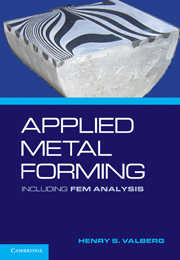Book contents
- Frontmatter
- Contents
- Preface
- APPLIED METAL FORMING
- 1 Characteristics of Metal Forming
- 2 Important Metal Forming Processes
- 3 FEA of Metal Forming
- 4 Theory
- 5 Reduction and Proportions of the Plastic Zone
- 6 Deformations from the Velocity Field
- 7 Technological Tests and Physical Simulation
- 8 Flow Stress Data
- 9 Formability and Workability
- 10 Friction and Friction Models
- 11 Thermal Effects
- 12 Experimental Metal Flow Analysis
- 13 Theoretical Methods of Analysis
- 14 Finite Element Analysis
- 15 FEA of Technological Tests
- 16 Forging
- 17 FEA of Forging
- 18 Extrusion
- 19 FEA of Extrusion
- 20 Rolling
- 21 FEA of Rolling
- 22 Drawing of Wire, Profiles, and Tubes
- 23 FEA of Wiredrawing
- 24 Sheet-Metal Forming
- Index
- References
9 - Formability and Workability
Published online by Cambridge University Press: 05 June 2012
- Frontmatter
- Contents
- Preface
- APPLIED METAL FORMING
- 1 Characteristics of Metal Forming
- 2 Important Metal Forming Processes
- 3 FEA of Metal Forming
- 4 Theory
- 5 Reduction and Proportions of the Plastic Zone
- 6 Deformations from the Velocity Field
- 7 Technological Tests and Physical Simulation
- 8 Flow Stress Data
- 9 Formability and Workability
- 10 Friction and Friction Models
- 11 Thermal Effects
- 12 Experimental Metal Flow Analysis
- 13 Theoretical Methods of Analysis
- 14 Finite Element Analysis
- 15 FEA of Technological Tests
- 16 Forging
- 17 FEA of Forging
- 18 Extrusion
- 19 FEA of Extrusion
- 20 Rolling
- 21 FEA of Rolling
- 22 Drawing of Wire, Profiles, and Tubes
- 23 FEA of Wiredrawing
- 24 Sheet-Metal Forming
- Index
- References
Summary
In connection with the discussion of technological tests in Ch. 7, it was stated that the tensile test specimen after some degree of stretching tends to become unstable, due to the onset of necking. With further stretching, there is neck growth in the specimen, and finally a fracture is formed in the neck, so that the specimen breaks into two pieces.
When compression testing was discussed, it was stated that for ductile metals, larger strains can in general be obtained in this test than in tensile testing, because neck formation is avoided in compression. But also in the compression test there are limitations on how much the specimen can be deformed. This is because various cracking phenomena may occur, especially when low-ductility materials are tested.
In metal forming, it is a common problem that the material of the workpiece breaks down during forming, in a manner like that for materials subjected to technological tests. In this chapter, different phenomena that cause material failure during metal forming operations will be discussed, with special emphasis on failure due to necking, tensile stress cracking, and shear cracking.
Formability and Workability
Formability and workability are terms that refer to the property of a material with regard to its ability to be shaped in metal forming without breakdown during the forming operation.
Information
- Type
- Chapter
- Information
- Applied Metal FormingIncluding FEM Analysis, pp. 127 - 138Publisher: Cambridge University PressPrint publication year: 2010
References
Accessibility standard: Unknown
Why this information is here
This section outlines the accessibility features of this content - including support for screen readers, full keyboard navigation and high-contrast display options. This may not be relevant for you.Accessibility Information
- 1
- Cited by
